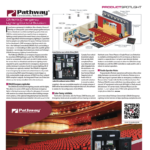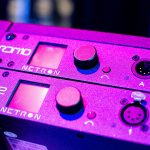Although Datapath has been around for a while, I only recently became aware of their product line. Having spec’d a rather large video wall a scant six months ago, Datapath frequently rose to the top of my Internet search as an external graphics box manufacturer, and they make some killer boxes. The company is mainly known for large, scalable wall controller servers and graphics capture cards, but they also offer a series of small-but-powerful multi-display units that are worth checking out.
The x4
The Datapath x4 is quite often found on many chat groups and forums as the “go-to” device for distribution of high-res signal. How many times have you been on a gig and needed to DA signal with some degree of reliability? A lot? Thought so.
It’s a smallish and unassuming device (as most in this category are), but it packs quite a punch. It’s billed as a “stand-alone display wall controller that accepts a standard single or dual-link DVI input and can flexibly display this across four output monitors.” But, as is the case with anything worthy, it’s so much more than that.
Anyone who has ever done a multi-projector blend will tell you that distribution of signal is key, and consistency of that signal is paramount. First off, the hardware:

As mentioned, it’s a smallish (two inches high and nine inches wide) box of wonder with screw down DVI ports that are programmable and gunlock-able. At high resolution, DVI signals cannot normally be guaranteed beyond five-meter cables, due to the nature of the signal losses inherent in the DVI cables and connectors. Datapath added active equalization hardware on the input to the x4, which is able to compensate for these losses and support cable lengths of up to 20 meters, even at full dual-link resolutions (330 MHz pixel clocks). Lower resolutions will allow even longer cable lengths. When it comes to DA’ing signal, you could go with just about any major manufacturer, but with Datapath, you get a software advantage that makes life so much easier. Using Datapath’s exclusive “Wall Designer” software makes multi-screen management completely manageable. Need to blend a four-wide of 1080p? Easy. Need to make a two-by-two pixel perfect? Easier still.
The Fx4
The Fx4 gets its good looks and guts from its predecessor, with nothing is left to the imagination. While the x4 was just DVI, the Fx4 is HDMI and DisplayPort. The Fx4 features a DisplayPort1.2 main input alongside two HDMI1.4 inputs offering 4K 4096x2160p at 60 fps or UHD 2160p at 30 fps respectively. The intuitive user interface lets users determine which input is used. It also lets users selectively switch between any input. Since it has a USB 2.0 port as well as Ethernet Thru ports, you can control the unit through either. Both Fx4’s in the chain I used were automatically recognized as soon as I fired up the included Wall Controller app.
The dL8
The x4 is a great 1×4 DA, but what if those four screens are just a destination as part of a larger multi-display? Feed it with the dL8! The dL8 is an eight output DA for ultra-high resolution dual-link DVI signals. If you used it with eight x4’s, you now have the capability to control a 32-screen configuration. One dual-link DVI output supporting graphics sources with pixel clocks up to 330 MHz and resolutions beyond Quad-HD can be delivered to eight outputs on separate DVI-D (dual-link) connectors. This DA supports up to 20m even at full dual-link resolutions due to additional active equalization and re-clocking hardware, allowing convenient location for flexible display designs. EDID is fully programmable as well as frame rates.
The Fx4-SDI
Live event and broadcast face additional challenges, not the least of which is distance. The soon-to-be-released SDI version will offer 3GSDI, DisplayPort 1.2 and HDMI 1.4 inputs, allowing up to 4K at 60fps, all on good old coaxial cable.
The Software
Datapath offers up their own proprietary software appropriately called “Wall Designer” to control these little beasts. The software is not quite as polished as what you’d find from some of the bigger box manufacturers, but it’s adequate and quite comfortingly Spartan.
In fact, I preferred it to many other apps that are too bloated with features I don’t need or extraneous crap that you end up chasing your tail on. You simply add the monitors (or projectors) you have from their quite extensive database, then proceed to lay them out in the physical config that you have. Once this is complete, add in the Datapath units you are using and then virtually patch them together. You can link any virtual device with a physical one at this point. If all goes well, you should have a working display.
There are many features unique to the Datapath software, such as bezel-correction (also works for the projection folks), individual pixel-perfect adjustment of whatever display is hooked to it. And, finally, durability.
I recently spec’d two Fx4’s for an 8-panel video wall, and I’m really impressed with the ease of use and feature set. I ended up using the DisplayPort outputs, so I can run 4K to my 2×4, and it looks stunning. I had the software installed and programmed in about 15 minutes.
You can get really creative and construct non-traditional multi-display configurations instead of the standard landscapes you see in airports, malls, boardrooms, and control rooms. Wall Designer allows you to slice and dice input sources in any way you want, so you could do circular, columnar, or even cylindrical set ups.
The Datapath x4, Fx4, its cousin, the dL8, and its soon-to-be-released brother, the Fx4-SDI, are all quite rugged and compact. All have rack-mount configurations and all are affordable. It looks like the computer folks have come to the aid of production once again.
At a Glance
Compact and Durable DA Devices
Datapath is mainly known for large, scalable wall controller servers and graphics capture cards, but they also offer a series of small-but-powerful multi-display DA units that are generating a lot of buzz in Internet chat rooms. This series includes the Datapath x4, Fx4, dL8 and Fx4-SDI.
Datapath x4, Fx4, dL8, Fx4-SDI
What They Are:
Distribution amplifiers
What They Do:
Distribute and amplify signal (duh). The unique thing is the included Wall Designer software, which allows you to slice and dice an input source to any number of outputs. Multi-screen goodness in small, affordable packages.
Specs:
Datapath x4
- Accepts dual-link DVI, single-link DVI or HDMI input
- Supports both DVI and analog RGB output monitors
- Supports image overlapping
- Available in two model sizes
Datapath Fx4
- Supports 4K at 60 fps
- Network interface allows platform independent control
- HDCP support on all inputs and outputs
Datapath dL8
- Supports up to 32 screens video walls when used with up to eight Datapath x4’s
- Supports any resolution or frame rate that can be used supported in either single or dual-link DVI
- Supports any resolutions up to and beyond Quad HD (3840×2160)
Fx4-SDI*
- Supports 4K at 60 fps, four SDI 1080p outputs
- Network interface allows platform independent control
- Adapt to changes in inputs by adjusting all scale factors
*Not available as this issue went to press, but coming soon, according to Datapath
Manufacturer: Datapath
More Info: datapath.co.uk


